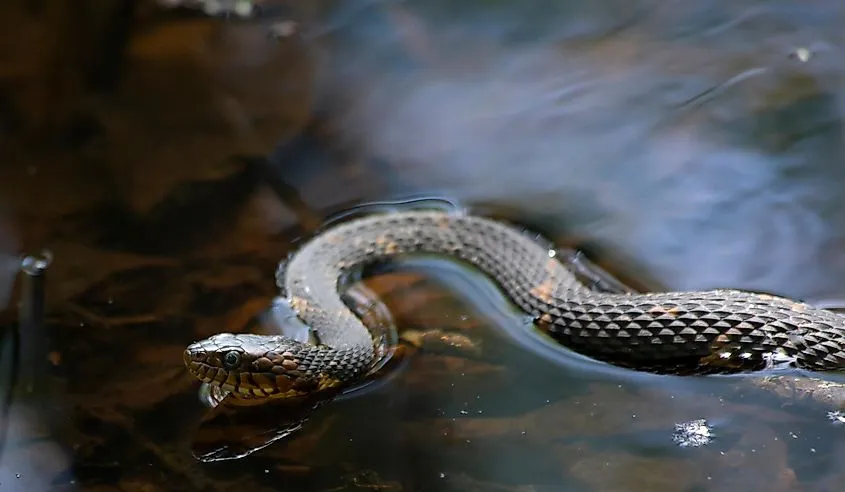In Ohio, where dense forests border picturesque lakes and marshes breathe untouched wilderness, snakes do not merely survive — they thrive. More than twenty species of reptiles inhabit the state's waters, creating a unique ecosystem that simultaneously captivates and repels. From harmless water snakes to rare venomous rattlesnakes — these lakes are true hotspots of biodiversity. However, for many locals and tourists, the very thought of encountering these reptiles causes shivering. According to WorldAtlas, five lakes in Ohio stand out for their particularly high concentration of snakes, and we will reveal why these bodies of water have become their habitat.
Lake Hope: Marshes, Cliffs, and Water Snakes
Located in the heart of Lake Hope State Park in southeastern Ohio, surrounded by the dense Zaleski Forest, Lake Hope is a magnet for wildlife enthusiasts — and a veritable paradise for snakes. Shallow coves, decaying vegetation, and abundant fish create ideal conditions for northern water snakes (Nerodia sipedon), which dominate these waters. Ecologists note that the marshy terrain and rocky shoreline facilitate the reproduction of these harmless reptiles, which hunt fish and amphibians. “This lake is a living example of how nature finds balance,” — says Dr. Emily Carter, herpetologist at Ohio University. “But for those afraid of snakes, this place can seem a real challenge.”
Kilbuck Marsh: Rattlesnakes Hiding Among Reeds
In the Kilbuck Marsh Reserve, spanning the boundaries of Wayne and Holmes counties, slow-moving channels and seasonal floods create a perfect environment for aquatic and semi-aquatic snakes. Northern water snakes and garter snakes (Thamnophis sirtalis) are common here, but the true rarity is the massasauga (Sistrurus catenatus) — a venomous rattlesnake endemic to Ohio. Dense reeds and muddy shores provide cover, while frogs and small invertebrates serve as a stable food source. The protected status of the reserve limits human intervention, allowing snakes to remain discreet rulers of these lands. “Kilbuck is a place where nature dictates its own rules,” — comments park ranger John Miller.
Salt Fork Lake: Snakes on Docks and in Bays
Within Ohio’s largest state park, where Salt Fork Lake is located, winding shoreline and isolated coves provide shelter for various reptiles. Northern water snakes, garter snakes, and ring-necked snakes (Diadophis punctatus) feel at home here, swimming in shallow warm waters or basking on fishing docks. Black Rat Snakes (Pantherophis obsoletus), known for their agility, patrol dry wooded areas. “Tourists often don’t realize they share space with these reptiles,” — says local guide Sarah Wilson. “Snakes here are so common that they have become part of the landscape.”
Caesar Creek Lake: Reptiles Among Flooded Forests
In southwestern Ohio, near Cincinnati, Caesar Creek Lake is surrounded by forests and wetlands, making it attractive for northern water snakes and black rat snakes. Floodplains and tributaries create an intricate network of habitats where reptiles hunt amphibians and small fish. During warm months, snakes are often seen near water bodies, basking on the sun amid semi-submerged vegetation. “This place reminds us that nature isn’t always welcoming,” — notes ecologist David Lynch, who studies regional biodiversity.
Lake Mosquito Creek in Trumbull County, surrounded by dense forests, supports an active population of northern water snakes and garter snakes. Shallow waters and abundant vegetation create perfect conditions for hunting and breeding. “This lake is a quiet haven for reptiles avoiding human hustle,” — says local biologist Caitlin Brown. Although venomous snakes are rare, the large number of harmless reptiles can make unwary visitors think twice before jumping into the water.
Why Do Snakes Inspire Fear and Fascination?
The majority of Ohio’s snakes pose no threat to humans, helping control rodent and insect populations. However, three venomous species — the eastern copperhead (Agkistrodon contortrix), massasauga, and timber rattlesnake (Crotalus horridus) — serve as reminders of the respect that wild nature demands. “Snakes are not enemies, but key players in the ecosystem,” — emphasizes Carter. “And for many, their presence in bodies of water is a reason to stay away.”
These five Ohio lakes are not only natural treasures but also centers where snakes demonstrate their resilience and adaptability. For some, these are places to avoid; for others, an opportunity to glimpse a world where nature remains unbound by humans. The question is, are you ready to step onto their territory?


